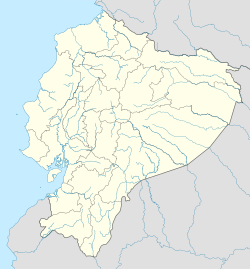You can help expand this article with text translated from the corresponding article in Spanish. (March 2009) Click for important translation instructions.
|
| Atuntaqui | |
|---|---|
| City | |
 | |
| Coordinates: 0°19′54″N 78°13′08″W / 0.33167°N 78.21889°W / 0.33167; -78.21889 | |
| Country | |
| Province | Imbabura |
| Canton | Antonio Ante Canton |
| Area | |
| • City | 10.37 km (4.00 sq mi) |
| Population | |
| • City | 25,115 |
| • Density | 2,400/km (6,300/sq mi) |
| Climate | Csb |
Atuntaqui is a city, with a population of 25,115, in the Imbabura Province in the northern region of Ecuador. The city is located at an altitude of 2,400 metres (7,900 ft). Atuntaqui is located just 13 kilometres (8.1 mi) from the larger city of Ibarra, north along the Panamerican Highway. Although the sector name is Antonio Ante, those who visit or have heard of it identify it more as Atuntaqui, a name that has acquired several meanings through history. According to Father Juan de Velasco, it is composed of two words - hatun (large) and taqui (drum), i.e. 'big drum'. Jacinto Jijón y Caamano identifies it as a 'land rich in truth'; González Suárez rejects this meaning and translates it as 'big barn'. Others call it 'place of the inn' or 'tightly closed town'.
Climate
The climate is dry and mild and it has an average annual temperature of 18 C.

Economy
On August 13, 1868 Atuntaqui was partially destroyed by an earthquake that left thousands dead and homeless. After its reconstruction and its subsequent development, the textile factory, which set up an hydroelectric plant on the banks of the Ambi river and the arrival of the railway in the town of Andrade Marín, located 2.5 km east of Atuntaqui, became especially important. Since 2000, it has been noted for its textiles and crafts. Every year the Atuntaqui Expo takes place here in the Carnival holidays, a day on which the city hosts a large number of visitors (140,000 visitors in the 2009 edition), who come to make purchases.
Government
The Local Government is the Municipal Council located in the Atuntaqui central square.
Tourism
Atuntaqui has great tourism potential, offering textiles, crafts, cuisine and culture, a varied and interesting mix to be enjoyed all year round.
Sister cities
References
- Citypopulation.de
- "Agreements Signed between DPRK and Ecuador". KCNA. 27 April 2008. Archived from the original on 8 September 2017.
Sources
- World-Gazetteer.com
| Canton seats in Imbabura | ||
|---|---|---|
This Ecuador location article is a stub. You can help Misplaced Pages by expanding it. |